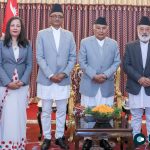
‘Nepal’s Mountaineering has changed a lot in 50 years’, Reinhold Messner
( A translated version of interview by RSS)
Reinhold Messner, a world-renowned mountaineer, explorer and travel writer, is currently on a visit to Nepal.
Born in Italy in 1944, Messner is one of the most influential mountaineers who has always loved Nepal, its art, culture and a well wisher of Nepali tourism. Seventy-seven-year-old Messner has conquered all 14 eight thousanders peaks and still has a keen interest in mountaineering in Nepal. Messner who visited Nepal for 50 times had started mountaineering since 1970.
He successfully climbed Mt. Nanga Parbat in 1970 and in 1978, Mt. Manaslu in 1972, Mt. Gasherbram I in 1975 and 1984. Similarly, he conquered Mt. Everest in 1978 and 1980, Mt K2 in 1979 and Mt. Shishpangma in 1981.
He also climbed Mt. Kanchenjunga in 1982 and 1984, Mt. Gasherbrum II and Broad Peak in 1984, Mt. Choyu in 1983, Mt. Annapurna and Mt. Dhaulagiri in 1985 and Mt. Makalu and Mt. Lhotse in 1986.
Messner is the first solo citizen to cross Antarctica and Greenland on his own, he also crossed the Gobi Desert alone. He has published more than 80 books about his experiences in climbing and exploring.
He came to Nepal to celebrate the New Year 2022 with his wife Diane Schumacher and stayed in Namche for a few days before returning to Kathmandu.
Here is a brief interview with Reinhold Messner by Krishna Adhikari, Chief Correspondent of the RSS.
What inspires you to visit Nepal ?
I have been enchanted with Nepal’s natural beauty and public’s affection towards me ever since I came here in my youth with the goal of climbing mountains here. Later my desire to conquer other mountains grew inside me after I climbed Mt. Everest for the first time in 1978. After climbing more mountains I came to know more about the Nepali people. I am grateful for being able to promote tourism in Nepal. I would like to give the credit of my expedition success to Nepal.
I am very much influenced by Nepali art and culture. I am very impressed with the cultural diversity and natural beauty here. Nepal is a piece of paradise, its inhabitants, mountains and natural beauty can not be described in words. I can’t forget the simple demeanor and smiling faces of Nepalis. The same fascination has inspired me to visit Nepal every year. I can’t help my heart to stop coming to Nepal at least once a year.

What differences do you find while climbing mountains back in your days and the current situation?
I have noticed large changes in these 50 years when I climbed the various mountain ranges to the present situation. At that time, the climbers had no idea about Nepali mountains. They had little information about mountain locality, and the proper route on the peak. The Sherpa guides used to be inexperienced in climbing mountains. But now we have enough information and information about the expedition, with the full support from experienced and skilled Sherpas.
Is the impact of climate change really visible in the mountainous region of Nepal?
Although Nepal’s role in greenhouse gas emissions is minimal, it has been severely affected by the effects of climate change. Climate change seems to have a direct impact on the Himalayan region of Nepal. The Himalayas, like Mt. Amadablam and Mt. Manaslu receives less snow than before.
Even the snow-capped peaks of yesterday have now started appearing nude black mountains. The greenhouse effect caused by ever growing carbon dioxide levels in the atmosphere has gradually increased mountain temperature lately. This has caused the eruption of glaciers, melting of glaciers and decreased snowfall in the mountains. Climate change has modified monsoon trends and air systems in the Himalayas making the expedition more risky. Disasters such as avalanches and blizzards have been increasing in the Himalayan region for some years now.
What should we do to reduce such incidents?
Such challenges are compounded by the fact that the entire climate system is out of balance due to industrialization, widespread use of vehicles, massive use of fossil fuels and consumerism. Nepal needs to raise its voice in international forums on the impact of climate change in the Himalayas, while stressing on internal work. We need to work a lot on systematic urbanization, use of clean energy and lifestyle change for good.

How much potential do you see in mountaineering tourism in Nepal?
As there is a lot of potential for mountain tourism in Nepal, it seems that long term programs and strategic plans should be devised for its development. Nepal is full of ‘Nature’, ‘Culture’ and ‘Adventure’. If Nepal can focus on development in a planned and sustainable manner, it can benefit a lot from tourism.
Nepal is known as a unique destination for mountain tourism as it covers more than 80 percent of the country with mountains and Himalayas. Majority of mountains above eight thousand meter tall are here in Nepal while the majority of the world’s longest mountain range also lies here. These facts make Nepal a travel haven.
You have made a great contribution in promoting Nepal’s tourism internationally. Have you thought about expanding it further in the coming days?
My articles have been published in more than 80 books and journals about my experience of climbing Nepal’s 8,000-meter-high mountains. Many of the documentaries I created have helped to introduce Nepal to the international community. As a Goodwill Ambassador to Nepal, I have been giving speeches on Nepal’s tourism and mountains in my native Italy and other European countries. I have built museums in different cities of Italy that reflect Nepali art and culture. These days I am working to build an art museum in Namche, Solukhumbu.
We are working to open a museum at the world’s tallest place next year. As I have a deep connection with Nepal’s tourism, I want to promote Nepali art, culture and tourism in the international arena for the rest of my life.
Are there any basic suggestions to be made by the Government of Nepal, tourism entrepreneurs and citizens for the promotion of Nepali tourism?
Tourists come to Nepal to experience the special rather than the mediocre experience. Managements should be made about providing tourist friendly environments about historical heritage, cultural-tradition, natural beauty, hospitality, adventure activities and sports and new places for sightseeing. Since most of the climbers who come to climb Nepal’s mountain do not bother to visit or enjoy other experiences. They directly want to go to the base camps in the mountain after landing in Kathmandu and return home directly from there via Kathmandu. Environments should be made for such expeditors to make them aware of the rich art, culture and diversity along with other trekking routes here which will help a lot in promoting tourism in Nepal.
Increasing use of mobile phones in Nepal, like in other developed cities in the world, have hindered the warm Nepali tradition to open up with tourists. This has sadden me. I am concerned to see that the activities like talking openly and greeting foreign guests are gradually decreasing. In the meantime, much work has been done in the field of tourism infrastructure, but there is still a long way to go in safe and orderly flight, hiking, hotel facilities, preservation of art and culture, and conservation of biodiversity.













Comments